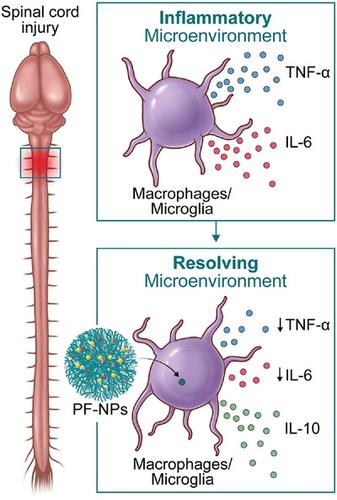当前位置:
X-MOL 学术
›
Adv. Therap.
›
论文详情
Our official English website, www.x-mol.net, welcomes your feedback! (Note: you will need to create a separate account there.)
Modulation of Neuroinflammation via Selective Nanoparticle-Mediated Drug Delivery to Activated Microglia/Macrophages in Spinal Cord Injury
Advanced Therapeutics ( IF 4.6 ) Pub Date : 2022-08-12 , DOI: 10.1002/adtp.202200083 Cinzia Stigliano 1 , Allison Frazier 1 , Philip J Horner 1
Advanced Therapeutics ( IF 4.6 ) Pub Date : 2022-08-12 , DOI: 10.1002/adtp.202200083 Cinzia Stigliano 1 , Allison Frazier 1 , Philip J Horner 1
Affiliation

|
Inflammation after spinal cord injury (SCI) is characterized by immune cell invasion and activation, combined with inflammatory mediator release that worsens outcomes following primary trauma. Effective therapies targeting neuroinflammation remain an unmet need, and modulation of the injury microenvironment to induce a comprehensive pro-regenerative response is an attractive therapeutic approach. Given its crucial role in cell stress and inflammation after SCI, the potential of pharmacologically targeting MAPK-activated protein kinase-2 (MK2) to modulate the response of microglia/macrophages after injury is focused. Nanoparticles (NPs) containing an MK2 inhibitor for specific targeting of microglia/macrophages is developed. NPs selectively target and modulate activated microglia/macrophages in vitro and in a rat model of SCI. NPs in the acute injury setting reduce the pro-inflammatory cytokine IL-6 and increase the anti-inflammatory cytokine IL-10. Importantly, NPs have a significant effect on microglia/macrophage distribution and accumulation, leading to ≈65% reduction of immune cells around the injury. Last, microglia/macrophage populations with activated morphology are significantly reduced compared to resting or ramified cells around the lesion site. This strategy exhibits potential therapeutic efficiency and specificity for local, pharmacologic manipulation of activated microglia/macrophages, and is a versatile tool to manage acute inflammation and glia plasticity after central nervous system trauma.
中文翻译:

通过选择性纳米颗粒介导的药物递送到脊髓损伤中活化的小胶质细胞/巨噬细胞来调节神经炎症
脊髓损伤 (SCI) 后炎症的特征是免疫细胞侵入和激活,并伴有炎症介质释放,这会恶化原发性创伤后的结果。针对神经炎症的有效疗法仍然是一个未满足的需求,调节损伤微环境以诱导全面的促再生反应是一种有吸引力的治疗方法。鉴于其在 SCI 后细胞应激和炎症中的关键作用,药理学靶向 MAPK 活化蛋白激酶 2 (MK2) 以调节损伤后小胶质细胞/巨噬细胞反应的潜力受到关注。开发了含有 MK2 抑制剂的纳米颗粒 (NP),用于特异性靶向小胶质细胞/巨噬细胞。NPs 在体外和 SCI 大鼠模型中选择性地靶向和调节活化的小胶质细胞/巨噬细胞。急性损伤环境中的 NP 可减少促炎细胞因子 IL-6 并增加抗炎细胞因子 IL-10。重要的是,NPs 对小胶质细胞/巨噬细胞的分布和积累有显着影响,导致损伤周围的免疫细胞减少约 65%。最后,与病变部位周围的静息或分支细胞相比,具有活化形态的小胶质细胞/巨噬细胞群显着减少。该策略对激活的小胶质细胞/巨噬细胞的局部药理学操作显示出潜在的治疗效率和特异性,并且是管理中枢神经系统创伤后急性炎症和神经胶质可塑性的多功能工具。NPs 对小胶质细胞/巨噬细胞的分布和积累有显着影响,导致损伤周围的免疫细胞减少约 65%。最后,与病变部位周围的静息或分支细胞相比,具有活化形态的小胶质细胞/巨噬细胞群显着减少。该策略对激活的小胶质细胞/巨噬细胞的局部药理学操作显示出潜在的治疗效率和特异性,并且是管理中枢神经系统创伤后急性炎症和神经胶质可塑性的多功能工具。NPs 对小胶质细胞/巨噬细胞的分布和积累有显着影响,导致损伤周围的免疫细胞减少约 65%。最后,与病变部位周围的静息或分支细胞相比,具有活化形态的小胶质细胞/巨噬细胞群显着减少。该策略对激活的小胶质细胞/巨噬细胞的局部药理学操作显示出潜在的治疗效率和特异性,并且是管理中枢神经系统创伤后急性炎症和神经胶质可塑性的多功能工具。
更新日期:2022-08-12
中文翻译:

通过选择性纳米颗粒介导的药物递送到脊髓损伤中活化的小胶质细胞/巨噬细胞来调节神经炎症
脊髓损伤 (SCI) 后炎症的特征是免疫细胞侵入和激活,并伴有炎症介质释放,这会恶化原发性创伤后的结果。针对神经炎症的有效疗法仍然是一个未满足的需求,调节损伤微环境以诱导全面的促再生反应是一种有吸引力的治疗方法。鉴于其在 SCI 后细胞应激和炎症中的关键作用,药理学靶向 MAPK 活化蛋白激酶 2 (MK2) 以调节损伤后小胶质细胞/巨噬细胞反应的潜力受到关注。开发了含有 MK2 抑制剂的纳米颗粒 (NP),用于特异性靶向小胶质细胞/巨噬细胞。NPs 在体外和 SCI 大鼠模型中选择性地靶向和调节活化的小胶质细胞/巨噬细胞。急性损伤环境中的 NP 可减少促炎细胞因子 IL-6 并增加抗炎细胞因子 IL-10。重要的是,NPs 对小胶质细胞/巨噬细胞的分布和积累有显着影响,导致损伤周围的免疫细胞减少约 65%。最后,与病变部位周围的静息或分支细胞相比,具有活化形态的小胶质细胞/巨噬细胞群显着减少。该策略对激活的小胶质细胞/巨噬细胞的局部药理学操作显示出潜在的治疗效率和特异性,并且是管理中枢神经系统创伤后急性炎症和神经胶质可塑性的多功能工具。NPs 对小胶质细胞/巨噬细胞的分布和积累有显着影响,导致损伤周围的免疫细胞减少约 65%。最后,与病变部位周围的静息或分支细胞相比,具有活化形态的小胶质细胞/巨噬细胞群显着减少。该策略对激活的小胶质细胞/巨噬细胞的局部药理学操作显示出潜在的治疗效率和特异性,并且是管理中枢神经系统创伤后急性炎症和神经胶质可塑性的多功能工具。NPs 对小胶质细胞/巨噬细胞的分布和积累有显着影响,导致损伤周围的免疫细胞减少约 65%。最后,与病变部位周围的静息或分支细胞相比,具有活化形态的小胶质细胞/巨噬细胞群显着减少。该策略对激活的小胶质细胞/巨噬细胞的局部药理学操作显示出潜在的治疗效率和特异性,并且是管理中枢神经系统创伤后急性炎症和神经胶质可塑性的多功能工具。


























 京公网安备 11010802027423号
京公网安备 11010802027423号